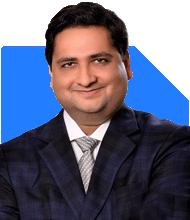Ramalingam Kalirajan |9712 Answers |Ask -Follow
Mutual Funds, Financial Planning Expert - Answered on May 11, 2024
He has an MBA in finance from the University of Madras and is a certified financial planner.
He is the director and chief financial planner at Holistic Investment, a Chennai-based firm that offers financial planning and wealth management advice.... more

I am 42 years salaried person investing in MF through SIP from 2014 current corpus is 37 Lakhs in MF. My Current SIP's amount is rs 22000 PM as follows- 1. Nippon Small cap - 2000, 2. Mahindra manulife midcap fund - 7000, Mahindra Manulife Small cap - 4000, PGIM Midcap opportunities Fund - 3000, Quant Flexicap fund - 6000. SIP increasing every year by 5% to 10% No Home loan, term insurance 55 lakhs, medi-claim 10 lakhs, PF & VPF accumulation Rs 16 lakhs. I want to create a good corpus of Rs 6 - 7crore for retirement at 58 years of age. Please suggest if any change required in investment amount or funds.
Your portfolio reflects a diversified mix of small-cap, mid-cap, and flexi-cap funds, which offer growth potential over the long term. However, given your goal of building a substantial corpus for retirement, we may need to reassess your asset allocation and make some adjustments.
Firstly, let's review your SIP amounts and consider increasing them gradually to accelerate wealth accumulation. Since your SIPs increase by 5% to 10% annually, this incremental growth can boost your investment corpus significantly over time.
Consider reallocating some of your SIP amounts to funds with a proven track record of consistent performance and lower volatility. While small-cap and mid-cap funds can offer higher returns, they also come with increased risk. Diversifying across large-cap funds or balanced funds can provide stability to your portfolio.
Moreover, review your overall asset allocation to ensure it remains aligned with your risk tolerance and investment objectives. While equity investments offer growth potential, it's essential to balance them with fixed-income securities like debt funds or PPF to mitigate risk.
Given your age and retirement horizon, periodically reassess your investment strategy and make necessary adjustments to stay on track towards your goal. Consider consulting with a Certified Financial Planner to develop a personalized retirement plan tailored to your needs and aspirations.
In conclusion, by fine-tuning your investment strategy, increasing your SIP amounts, and maintaining a disciplined approach, you can work towards achieving your retirement goal of building a corpus of Rs 6 - 7 crores by the age of 58.
Best Regards,
K. Ramalingam, MBA, CFP,
Chief Financial Planner,
www.holisticinvestment.in
You may like to see similar questions and answers below
Hardik Parikh | Answer |Ask -Follow
Tax, Mutual Fund Expert - Answered on Apr 19, 2023
Ramalingam Kalirajan |9712 Answers |Ask -Follow
Mutual Funds, Financial Planning Expert - Answered on Jun 19, 2024
Ramalingam Kalirajan |9712 Answers |Ask -Follow
Mutual Funds, Financial Planning Expert - Answered on Oct 03, 2024
Ramalingam Kalirajan |9712 Answers |Ask -Follow
Mutual Funds, Financial Planning Expert - Answered on Oct 10, 2024
Milind Vadjikar | Answer |Ask -Follow
Insurance, Stocks, MF, PF Expert - Answered on Nov 17, 2024
Radheshyam Zanwar |5309 Answers |Ask -Follow
MHT-CET, IIT-JEE, NEET-UG Expert - Answered on Jul 13, 2025
Nayagam P P |8705 Answers |Ask -Follow
Career Counsellor - Answered on Jul 13, 2025
Radheshyam Zanwar |5309 Answers |Ask -Follow
MHT-CET, IIT-JEE, NEET-UG Expert - Answered on Jul 13, 2025
Radheshyam Zanwar |5309 Answers |Ask -Follow
MHT-CET, IIT-JEE, NEET-UG Expert - Answered on Jul 13, 2025
Radheshyam Zanwar |5309 Answers |Ask -Follow
MHT-CET, IIT-JEE, NEET-UG Expert - Answered on Jul 13, 2025
Nayagam P P |8705 Answers |Ask -Follow
Career Counsellor - Answered on Jul 13, 2025
Nayagam P P |8705 Answers |Ask -Follow
Career Counsellor - Answered on Jul 13, 2025
Nayagam P P |8705 Answers |Ask -Follow
Career Counsellor - Answered on Jul 13, 2025
Radheshyam Zanwar |5309 Answers |Ask -Follow
MHT-CET, IIT-JEE, NEET-UG Expert - Answered on Jul 13, 2025
Radheshyam Zanwar |5309 Answers |Ask -Follow
MHT-CET, IIT-JEE, NEET-UG Expert - Answered on Jul 13, 2025




















